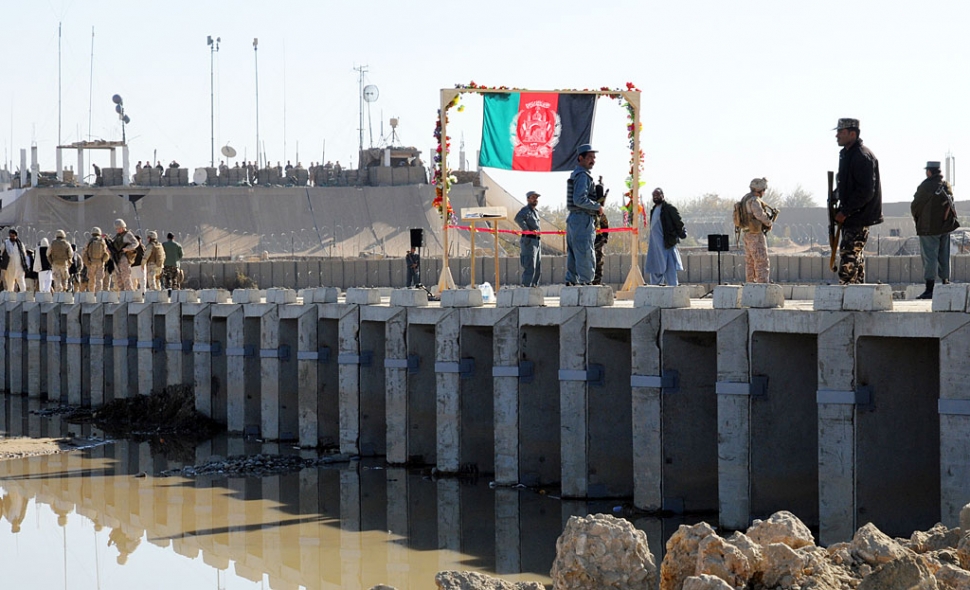|
NMCB FOUR Completes the Musa Qal’eh Crossing
 MUSA QAL’EH, Helmand, Afghanistan (December 09, 2011) The Musa Qal’eh low water crossing built by Naval Mobile Construction Battalion (NMCB) FOUR Seabees prior to the ribbon cutting ceremony. NMCB FOUR is a component of the Navy Expeditionary Combat Command that provides contingency engineering and construction across Afghanistan in support of the overall mission of International Security Assistance Forces and regional commander requirements. (U.S. Navy photo by Mass Communication Specialist 1st Class Russell Stewart/RELEASED) By Anonymous — Tuesday, December 13th, 2011
Written By MC1 Russ Stewart MUSA QAL’EH, Afghanistan (December 09, 2011) – In a crowd of dignitaries and elders the Musa Qal’eh crossing built by Naval Mobile Construction Battalion (NMCB) FOUR was blessed and declared open to the public in a ceremony held atop the roadway December 09, 2011. “[This project] represents what Seabees have done for 69 years. We don't just build facilities and roads; we build partnerships, lasting legacies, solutions, and linkages to improve people's lives,” said Cmdr. La Tanya Simms, NMCB FOUR’s commanding officer. “This low water crossing links Musa Qal'eh residents with the Gereshk Road and Helmand province's capital, Lashkar Gah, to facilitate economic growth and governance. That's a big deal! Our Seabees and the entire Musa Qal'eh team should be justifiably proud!” Standing on the crossing, seeing the village elders and district leaders gathered, looking at what his Seabees had accomplished in such a short span of time, NMCB FOUR’s Command Master Chief, Construction Utilities Master Chief Michael Jenkins said, “I was very proud to see the troops get the recognition from Major General Toolan. The smiles on the faces of the village elders and the district leaders said it all!” The wadi crossing project was truly a joint effort by Navy, Marine Corps, and Army commands, not just NMCB FOUR. Soldiers from the 129th and 375th Combat Sustainment Support Battalions convoyed precast components from Camp Leatherneck to Musa Qal'eh; Marines from the 7th Engineer Support Battalion (ESB) improved low spots on the road leading to Musa Qal'eh, welders from 7th ESB and Combat Logistics Battalion 6 were also an integral part of the construction crew, and the 2/4 Marines based at Musa Qal'eh provided security and helped procure the rip-rap placed at the base of the crossing to prevent erosion. Personnel from 2nd Marine Division (Forward) G9 included Cmdr. Edward Leitz, the G9 project manager, and Zack Mazraani, the civilian structural engineer who designed the crossing and worked with NMCB FOUR closely to refine the design for ease of construction. “It is unique for Seabees to undertake such a project in Afghanistan because over the last decade, Seabee projects have been more expeditionary in nature and primarily for coalition forces. This structure was designed and built to be more permanent and it's primarily for Afghan citizens,” said Simms. “There’s a giant difference doing work for the Afghan people instead of always for the US military; there’s a lot of satisfaction. It’s a really good feeling hearing ‘manana,’ or thank you, from the people as they drove or walked by us while we were working,” said Steelworker Constructionman James McMahan. McMahan worked on the crossing since its start in September this year. “The best part of this project was watching as our crew developed from zero experience to really proficient welders so rapidly!” said Steelworker 1st Class Douglas White. “There’s a great sense of accomplishment knowing that our job here has a direct contribution to the counterinsurgency effort.” Watching the ribbon cutting at the opening ceremony reminded Cmdr. Simms of situations during a past deployment in Indonesia when she was a Lieutenant. “There was a similar atmosphere where village leaders gathered to bless the projects, show their appreciation, and speak about cooperation between nations. Seabees, in Indonesia and Musa Qal'eh, understood the impact they were making both then and in the future,” she said. “They didn't have to understand Indonesian or Pashto; they could see the appreciation in people's smiles. Seabees are excellent contributors to what we call ‘Phase Zero’ operations, the business of preventing war,” said Simms. |
